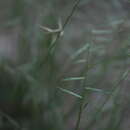Comprehensive Description
provided by North American Flora
Bouteloua aristidoides (H.B.K.) Griseb. Fl. Brit. W Ind. 537. 1864.
Dinebra aristidoides H.B.K. Nov. Gen. & Sp. 1 : 171. 1816.
Atheropogon aristidoides R. & S. Syst. Veg. 2: 415. 1817. (Based on Dinebra aristidoides H.B.K.)
Eutriana aristidoides Trin. Gram. Unifl. 242. 1824. (Based on Atheropogon aristidoides R. & S.)
Dinebra hirsuta Presl, Rel. Haenk. 1: 292. 1830. (Type from Peru, Haenke.)
Eutriana hirsuta Kunth, R^v. Gram. 1: Suppl. XXIII. 1830. (Based on Dinebra hirsuta Presl.)
Bouteloua gracilis "Hook.?"; Vasey, in Rothr. Bot. Wheeler's Surv. 287. 1878. (Type from
Arizona, Rothrock 701.) Bouteloua ciliata Griseb. Abh. Ges. Wiss. Gott. 24: 302. 1879. (Type from Juramento, Argentina,
Lorentz & Hieronymus 352.) Triathera aristidoides Nash, in Small, Fl. SE. U. S. 137, 1327. 1903. (Based on Dinebra aristidoides
H.B.K.) Bouteloua aristidoides var. arizonica M. E. Jones, Contr. W. Bot. 14: 13. 1912. (Tucson, Arizona,
Thornber 177.)
Annual; culms slender, branching, decumbent-spreading, geniculate, 10-40 cm. (usually 15-25 cm.) tall, glabrous; sheaths much shorter than the internodes, glabrous, hispid at the mouth; ligule ciliate, about 0.5 mm. long; blades flat or drying involute, attenuate-pointed, 1-6 cm. or rarely as much as 10 cm. long, 1-2 mm. wide, glabrous below, scabrous and sparsely pilose above; spikes few to several, 1-2 cm. long, abruptly spreading or reflexed, falling entire, the sharp-pointed base densely pubescent with stiff appressed hairs; spikelets 2-6, appressed, distant, the lowest one without the 3-awned rudiment; first glume narrow or subulate, 1-nerved, 1-3 mm. long, the second broader, 3-nerved, 5-6 mm. long; lemma acuminate, about 5 mm. long, more or less pilose; minutely toothed; awns of rudimentary floret about 5 mm. long, somewhat spreading.
Type locality: Mexico (Humboldt 6* Bonpland).
Distribution: Deserts, mesas, and dry open ground, western Texas to southern California and northern Mexico; also from Peru and Brazil to Argentina.
- bibliographic citation
- Albert Spear Hitchcock, Jason Richard Swallen, Agnes Chase. 1939. (POALES); POACEAE (pars). North American flora. vol 17(8). New York Botanical Garden, New York, NY
Physical Description
provided by USDA PLANTS text
Annuals, Terrestrial, not aquatic, Stems nodes swollen or brittle, Stems geniculate, decumbent, or lax, sometimes rooting at nodes, Stems caespitose, tuft ed, or clustered, Stems terete, round in cross section, or polygonal, Stems branching above base or distally at nodes, Stem internodes hollow, Stems with inflorescence less than 1 m tall, Stems, culms, or scapes exceeding basal leaves, Leaves mostly basal, below middle of stem, Leaves conspicuously 2-ranked, distichous, Leaves sheathing at base, Leaf sheath mostly open, or loose, Leaf sheath smooth, glabrous, Leaf sheath hairy at summit, throat, or collar, Leaf sheath and blade differentiated, Leaf blades linear, Leaf blades 2-10 mm wide, Leaf blades mostly flat, Leaf blade margins folded, involute, or conduplicate, Leaf blades mostly glabrous, Leaf blades more or less hairy, Leaf blades scabrous, roughened, or wrinkled, Ligule present, Ligule a fringed, ciliate, or lobed membrane, Inflorescence terminal, Inflorescence with 2 or more spikes, fascicles, glomerules, heads, or clusters per culm, Inflorescence a panicle with narrowly racemose or spicate branches, Inflorescence w ith 2-10 branches, Inflorescence branches more than 10 to numerous, Inflorescence branches 1-sided, Flowers bisexual, Spikelets sessile or subsessile, Spikelets laterally compressed, Spikelet less than 3 mm wide, Spikelets with 1 fertile floret, Spikelets solitary at rachis nodes, Spikelets all alike and fertille, Spikelets bisexual, Inflorescence branches deciduous, falling intact, Spikelets secund, in rows on one side of rachis, Rachilla or pedicel glabrous, Glumes present, empty bracts, Glumes 2 clearly present, Glumes distinctly unequal, Glumes equal to or longer than adjacent lemma, Glume equal to or longer than spikelet, Glumes 1 nerved, Lemma coriaceous, firmer or thicker in texture than the glumes, Lemma 3 nerved, Lemma glabrous, Lemma body or surface hairy, Lemma apex acute or acuminate, Lemma awnless, Lemma margins thin, lying flat, Lemma straight, Palea present, well developed, Palea membranous, hyaline, Palea shorter than lemma, Palea 2 nerved or 2 keeled, Stamen s 3, Styles 2-fid, deeply 2-branched, Stigmas 2, Fruit - caryopsis, Caryopsis ellipsoid, longitudinally grooved, hilum long-linear.
Bouteloua aristidoides: Brief Summary
provided by wikipedia EN
Bouteloua aristidoides, the needle grama, is an annual desert grass (Poaceae) found in California, Arizona, and western North America.
- license
- cc-by-sa-3.0
- copyright
- Wikipedia authors and editors

